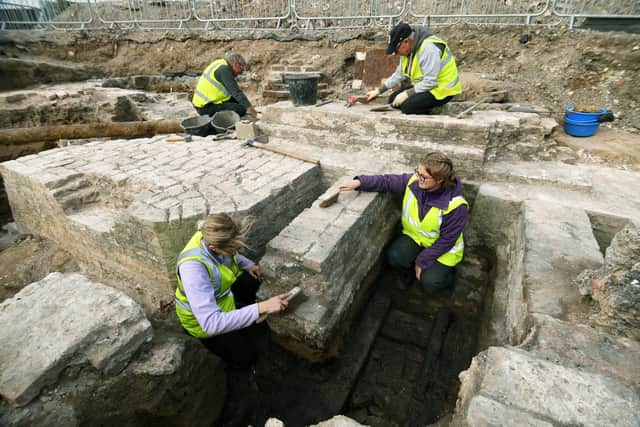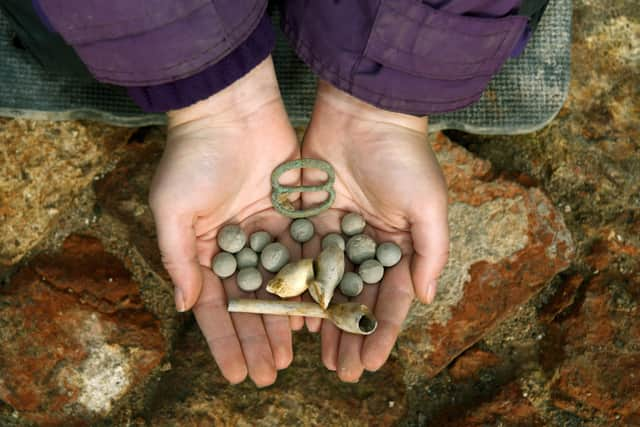Inside a Tudor fortress: Yorkshire dig reveals tantalising details of the past
Built between 1541 and 1543 to guard the mouth of the River Hull - then a harbour - from hostile ships, the South Blockhouse was part of an impressive set of defences built by Henry VIII.
Later a prison, the brick-built building, which had an unusual clover-leaf design, was finally demolished in the 1860s and now lies under a car park.
Advertisement
Hide AdAdvertisement
Hide AdFew visitors to the popular aquarium realise they are so close to an ancient scheduled monument.


There have been a couple of digs on the site in recent years, but this summer’s has been the most ambitious yet, with the largest community archaeology excavation seen in the city for over 25 years taking place.
A team led by Humber Field Archaeology has taken a slice through the centre of the fortress, exposing parts which haven’t seen the light of day for 160 years.
The fortress had extremely thick walls - more than 13ft wide at the base - rising to two storeys, with gun-ports on each level.
Advertisement
Hide AdAdvertisement
Hide AdThis summer’s dig has revealed the original Tudor wall which surrounds a central courtyard.


Gun ports can also be seen, where the cannon would have sat, and next to them, at hip height, the compartments where the cannon balls and gunpowder was stored.
There were as many as 30 cannon – some facing across the river Hull to the Old Town, as well as out to the estuary from whence invasion could come.
On the bottom of the chambers excavators found quite a few clay pipes – suggesting soldiers were quite relaxed about having a smoke, despite the risk of igniting the gunpowder.
Advertisement
Hide AdAdvertisement
Hide AdThe bowls of the earliest clay pipes, which date from the late 16th century, are quite small – tobacco is thought to have arrived in the UK as early as 1565 and was very expensive.
As smoking became more popular the bowls – they have examples all the way through to the late 19th century – got bigger.
It seems that the purpose of the fortress as a deterrent worked – its cannons were never fired in anger.
It later became a prison housing Catholic dissenters, some of whom were cruelly imprisoned for years in rooms which overflowed on a high tide.
Advertisement
Hide AdAdvertisement
Hide AdArchaeologists haven't found any evidence of the prison - but there is standing water in the trenches, showing how high the water table still is.
The team has been impressed by how well built it was.
Pete Connolly, from Humber Field Archaeology, Hull Council’s in-house archaeologists, said: "What's amazing is being able to see how well made the original Tudor building was - it was in use for over 350 years.
"You can see how often they were having to deal with water, putting in big culverts, raising the floor up and changing the floor design.
"There was this battle with nature - a battle we still have to do."
Advertisement
Hide AdAdvertisement
Hide AdPeople today have the chance to see what this summer’s dig has revealed, before it gets covered over again.
From 10.30am until 3pm, visitors can find out more about the fortress.
There will be a finds display, art displays inspired by the dig, children’s activities, traditional music, arts and crafts, and an opportunity to sample some Tudor inspired food.
Councillor Paul Drake-Davis, Portfolio Holder for Regeneration, said: “The 11-week excavation has given all of us the opportunity to really find out more about this wonderful historic site.
Advertisement
Hide AdAdvertisement
Hide Ad“This open day will offer visitors the chance to meet the team behind the excavation as well discover more about the Tudor fortification, its significance, why the excavation has taken place and the future plans.”
Hull Council was awarded £1m funding from Highways England to deliver a programme of archaeological works to conserve and create the attraction.
Looking ahead the plan is to turn the site into a landscaped area where people can come and learn about the fortress buried beneath. Manser Practice has been appointed to design the landscaping, and physical and digital heritage interpretation for the site.
